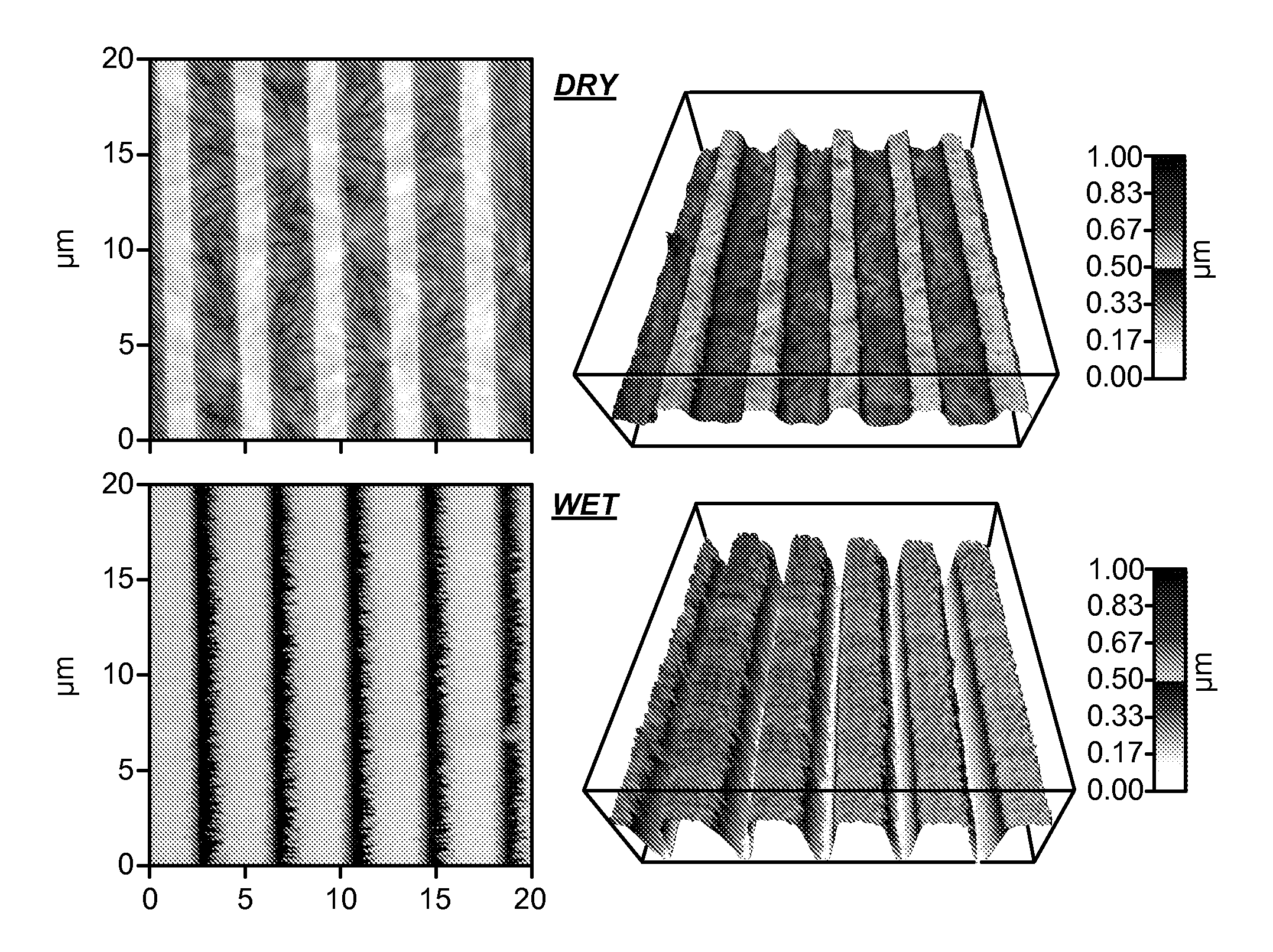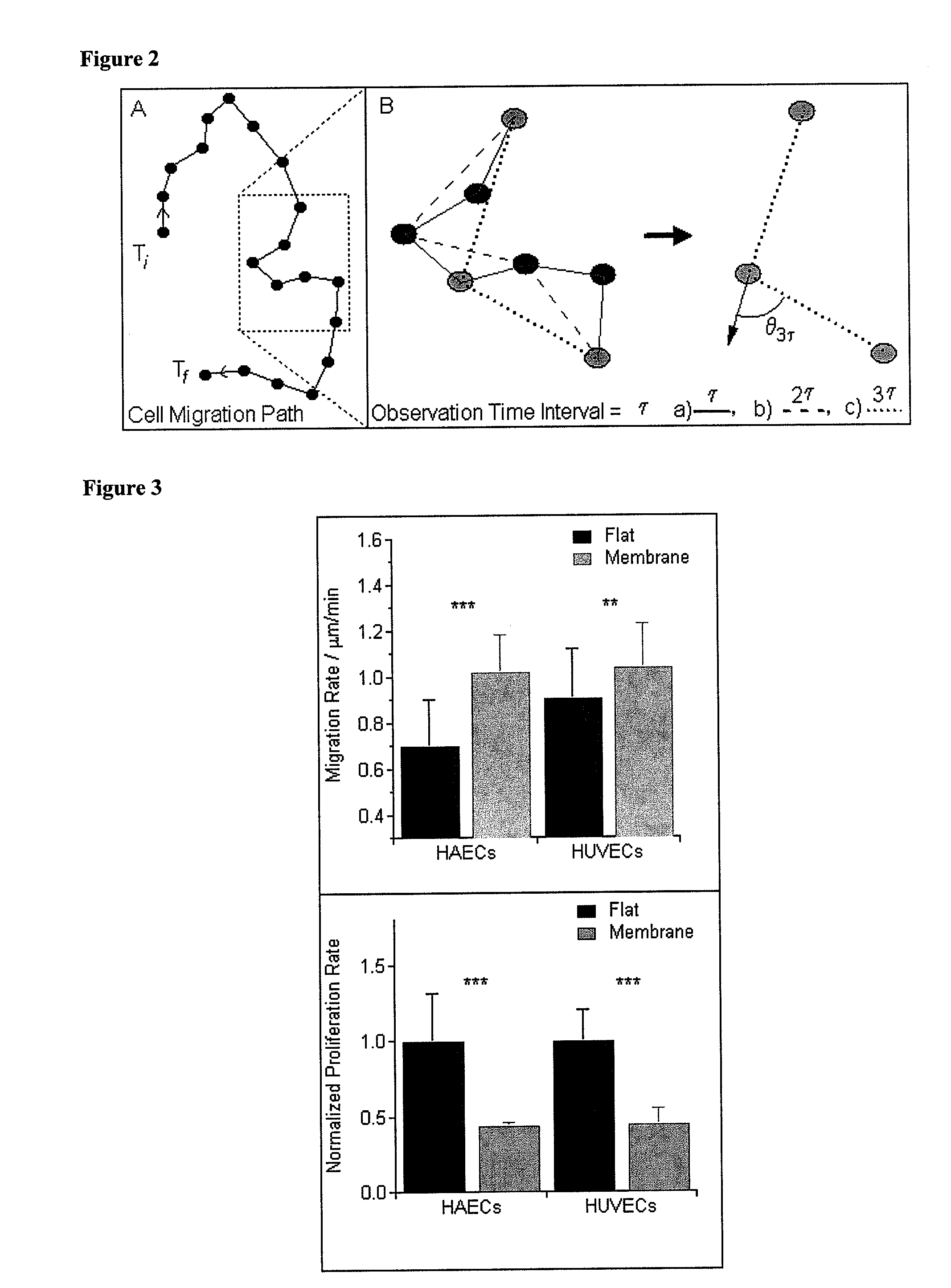Synthesis of nanotopographic biomimetic membranes for tissue culture, engineering and prosthetics applications
- Summary
- Abstract
- Description
- Claims
- Application Information
AI Technical Summary
Benefits of technology
Problems solved by technology
Method used
Image
Examples
example 1
Synthesis of Nanostructured Biomimetic Membrane Materials
[0097]Nanostructured membrane fabrication. Stabilized nanoporous membranes were generated by forming porous polyelectrolyte membranes (PEMs) of poly(acrylic acid) (PAA, MW˜60,000, Polysciences, Inc., Warrington, Pa.) and poly(allylamine hydrochloride) (PAH, MW˜160,000, Alfa Aesar, Ward Hill, Mass.) on glass microscope slides. Solutions of PAA and PAH were prepared at 0.01 M (based on MW of monomer unit) at a pH of 3.5 and 7.5, respectively. Solutions were prepared using ultra-high purity water (18.2 MΩ.cm) and the pH was controlled with NaOH and HCl. Before PEM formation, the glass microscope slides were plasma treated (Harrick Plasma Cleaner, Hayrick Plasma, Ithaca, N.Y.) for one minute and then immediately silanized by exposure to 3-aminopropyltrimethoxysilane (APS, Sigma Aldrich) vapor for 1 hour under vacuum. After 1 hour in the presence of APS vapor, the APS was removed and the samples were left under vacuum for 24 hours ...
example 2
Study of Cell Proliferation and Migration on Nanostructured Biomimetic Membranes
[0105]Cell culture. Human umbilical vein endothelial cells (HUVECs) and human aortic endothelial cells (HAECs) were maintained in endothelial basal media supplemented with EGM-2 BulletKit (Lonza, Walkerville, Md.). The BulletKit contains GA-1000, hEGF, fetal bovine serum, heparin, ascorbic acid, R3-IGF, VEGF, hFGF-B and hydrocortisone. During culture and migration assays, cells were maintained at 37° C. and 5% CO2.
[0106]Cell Migration Analysis via a Custom Automated Cell Tracker. Time-lapse observations of cells were obtained on both the flat and membrane surfaces over a 12-hour time period, with a collection rate of one frame every eight minutes (90 frames). Cells were imaged in phase contrast using an inverted light microscope (Zeiss, Axio Observer Al, Carl Zeiss, Thornwood, N.Y.) with a 10× objective. Cells from a minimum of ten separate locations were imaged for each condition. Cells were plated at 7...
example 3
Analysis of Gene Expression in Endothelial Cells Cultured on Biomimetic Nanostructured Membranes
[0116]Gene expression assays. Both HUVECs and HAECs were plated at 100,000 cells per plate and allowed to culture for three days on the flat and membrane surfaces prior to RNA extraction. Expression of SPARC (secreted protein acidic and rich in cysteine), PECAM (platelet endothelial cell adhesion molecule), and MMP-2 (matrix metalloproteinase-2) was quantified for both HUVECs and HAECs. The influence of TNFα (tumor necrosis factor-alpha) on the expression of ICAM-1(intercellular adhesion molecule-1) in HAECs was also studied. For those experiments, HAECs were exposed to 10 ng / ml TNFα for 12 hours prior to RNA extraction. RNA was extracted using the Qiagen RNeasy kit according to the manufacturer's protocol (Qiagen, Valencia, Calif.). Semi-quantitative real-time PCR was performed using 75 ng of RNA per reaction and a one-step TaqMan kit with commercially available aptamers for SPARC, PECAM...
PUM
| Property | Measurement | Unit |
|---|---|---|
| Length | aaaaa | aaaaa |
| Nanoscale particle size | aaaaa | aaaaa |
| Phase separation | aaaaa | aaaaa |
Abstract
Description
Claims
Application Information
 Login to View More
Login to View More - R&D
- Intellectual Property
- Life Sciences
- Materials
- Tech Scout
- Unparalleled Data Quality
- Higher Quality Content
- 60% Fewer Hallucinations
Browse by: Latest US Patents, China's latest patents, Technical Efficacy Thesaurus, Application Domain, Technology Topic, Popular Technical Reports.
© 2025 PatSnap. All rights reserved.Legal|Privacy policy|Modern Slavery Act Transparency Statement|Sitemap|About US| Contact US: help@patsnap.com



